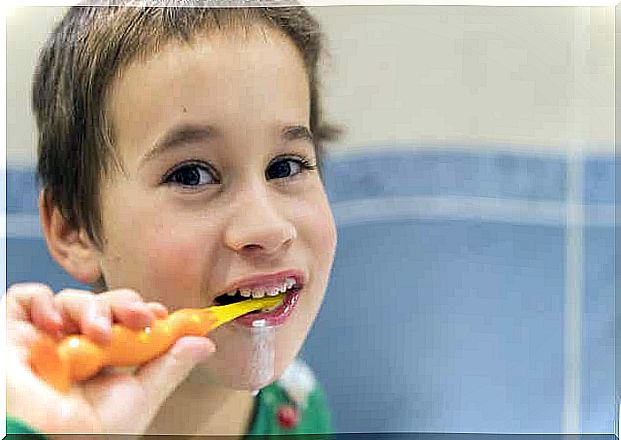Is Fluoride Good Or Bad For Children And Their Oral Health?

Many parents wonder if fluoride is a safe substance to use when it comes to children’s oral hygiene, and even their own. It is logical to wonder if there are risks, given the reports showing the long-term neurotoxicity of this substance. What is the recommended concentration and how is it administered to children?
Confusion and hesitation have arisen after the American Dental Association (ADA) a few years ago recommended that children under the age of 2 should not use fluoride, or wait until they can spit.
But today, and ever since 2014, the union has changed. After extensive reviews and research, it now suggests that we can start using it in small amounts as soon as the teeth appear.
In today’s article, we tell you what fluoride is and how it can prevent cavities and caries. We will also explain the risks involved with this substance, and what is the best way to use it in children.
What is fluorine?
Fluorine is a naturally occurring chemical. It occurs in soil, air and water. How concentrated it is in water depends on its origin.
It is also found in small amounts in certain foods such as oily fish, vegetables (cabbage and spinach), fruits (grapes), cereals (wheat and rice) and in black tea.

This mineral is very effective in dental care due to its ability to prevent cavities in the teeth. In combination with tooth enamel, hydroxylapatite, which is what tooth enamel consists of, changes to fluorapatite. This material is much more resistant to bacterial acids.
Why is fluoride recommended for children?
Fluoride plays an important role in strengthening children’s teeth and bones. As we mention above, it improves the quality of the enamel and resistance to the acids that bacteria produce in the mouth. This allows fluoride to prevent the onset of caries and also treat the first signs of this disease.
Caries is one of the most common diseases in childhood. It is a multifactorial condition in which the bacteria in the mouth – in combination with other nutritional and social factors as well as the child’s individual characteristics – produce acids that remove minerals from the teeth.
Removing these bacteria mechanically, through toothbrushing, is essential to prevent this disease. Research has shown that the use of fluoride in oral hygiene reduces the risk of caries.
On the one hand, its effect is to inhibit or delay the demineralization of the enamel. On the other hand, it promotes remineralization when crystals have already been broken down. In addition, the presence of fluoride in the mouth reduces the spread of bacteria.
How can children use fluoride in their oral hygiene?
Children can use fluoride in two main ways. One is by eating product that contains the mineral. The second is through oral hygiene, where you apply the substance directly to the mouth.
Fluoride through the diet
This means that fluoride enters the body through food or through drinking water. It is absorbed by the digestive mucosa, passes into the bloodstream and is then distributed to the tissues and deposited mainly in the bones and teeth.
The most common way to incorporate fluoride in this way is through drinking water. In this case, you should ensure that the water contains an optimal and safe concentration (max. 1.5 milligrams per liter according to the Swedish National Food Administration). This is because higher levels can be toxic, and lower levels can mean that you need supplements if you have a high risk of caries.
In most cases, public tap water is said to contain optimal levels of fluoride and be safe for the public.
The effect of fluoride in the body of children occurs during the baby tooth period, ie when teeth are still forming in the bones. The availability of fluoride via food and water during tooth formation is advantageous, but the caries prevention effect is less compared to applying fluoride such as toothpaste.
Fluoride through dental products
This means that fluoride is applied directly to the teeth. The most effective way is to do this when the tooth has just come up, as it is more porous at this stage and can better absorb the mineral. We are referring here to the use of toothpastes and mouthwashes as well as gels and varnishes used by dentists.

Fluoride toothpaste is what most parents use at home with their children. The important thing is to ensure that the fluoride concentration is appropriate for the child’s age.
The ADA recommends a fluorine concentration of 500 parts per million (ppm) in toothpaste for children from 0 to 3 years. From 3 to 6 years they recommend 1000 ppm and for children over 6 years 1500-2000 ppm.
As the mineral content is higher in the latter group , you should be careful about how much toothpaste you put on the brush and try to prevent the child from swallowing it.
As we mentioned above, experts now consider it appropriate to start brushing children’s teeth with fluoride toothpaste as soon as the teeth come up. Just place a small click on the toothbrush (less than a grain of rice) and brush the baby’s teeth, a maximum of twice a day.
A tip is to tilt the baby’s head slightly downwards when brushing; this means that toothpaste and saliva flow out into the sink rather than down the throat. Remember that this product should never be swallowed!
From the age of 3, the amount of toothpaste should be as large as a pea, and you should remind children to always spit it out and never swallow. It is at this age that children begin to learn to spit. An adult should brush their baby’s teeth until they are 6 to 7 years old, and then monitor them when they brush themselves.
Other fluoride products for children
When it comes to fluoride rinses, this is something that a dentist prescribes when needed depending on the child’s individual risk of caries. In general, this is not recommended before the age of six, as it is important that the child knows how to spit out the product properly.
The gels and varnishes we mention above are those used for professional use, in dental surgery. The dentist applies these according to each child’s individual needs. It is common to apply fluoride to newly formed permanent teeth.
Risks of fluoride use in children
Studies show that regular use of fluoride does not pose a risk to human health. The most common risk is dental fluorosis; however, this is not so common.
This is a condition that results from excessive consumption of fluoride during the period of tooth formation. From the age of 8, after all the teeth have come up in the baby’s mouth, the risk decreases.
Dental fluorosis is linked to drinking water with a high fluoride content in specific areas – which is water that has not been analyzed correctly. The risk from topical use of dental products is very small, except in cases of unintentional excessive intake.
Dental fluorosis appears as white, yellow or brown spots on the tooth surface, depending on how affected the teeth are. It usually does not affect tooth function or cause any pain; it’s just a change in appearance.
To reduce the risk of dental fluorosis, it is important to check the fluoride content of your drinking water. It is also important to use a toothpaste with adequate mineral concentration for the age of the child and to use only the recommended amount.
Again, teaching your child to spit and not swallow the toothpaste is also very important. Toothbrushing up to 6 years should be performed by an adult and then monitored. It is a good idea to keep toothpastes and other oral care products out of the reach of children.
If the child swallows a small amount of toothpaste, there is no danger. However, if the child swallows a relatively large amount (some children like to eat toothpaste), they may have stomach problems.
In these cases, you should consult your pediatrician or call the Poison Information Center on 112 to be sure. Experts recommend allowing your baby to drink a large amount of milk because calcium binds to fluoride in the stomach.

The benefits of fluoride outweigh the risks
The fact that children use fluoride is very useful in preventing the appearance of cavities in the teeth, which is very common in young children. The key is to achieve a balance between giving enough fluoride to avoid dental problems and not giving it in excess and causing other problems. The Swedish Dental Association says that fluoride toothpaste that is used correctly is safe.
If you are unsure whether to use fluoride for your children’s oral hygiene, it is always a good idea to consult your dentist. This can evaluate the risk of cavities and caries and will be able to provide appropriate advice for each individual case.
If you prefer to use toothpaste without fluoride, you should know that this only helps to clean the teeth and create a pleasant feeling and taste in the mouth. It does not provide the extra protection against caries in the same way as fluoride products do.
No matter what decision you make, it is always important to brush your teeth to ensure that you get rid of all the plaque. Another important thing is regular visits to your dentist. For children, these visits are important to enable early detection of any problems and prompt action.









